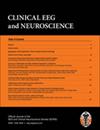原创研究:独特儿科脑电图配置的临床意义:双额叶尖峰与双枕叶同时阳性
IF 1.7
4区 医学
Q3 CLINICAL NEUROLOGY
引用次数: 0
摘要
简介以额叶为主的癫痫样放电(ED)包括泛化尖波(GSW)和额叶尖波(FS)。然而,双额叶负性放电同时伴有枕叶阳性(BFOD)的情况非常罕见,这就引起了有关生理发生因素的问题。方法:为了确定 BFOD 的临床意义,将 BFOD 儿童(n = 40)的电临床特征与 GSW(n = 102)和 FS(n = 100)的对照组患者进行了比较。结果如下结果按以下顺序排列:BFOD、GSW 和 FS。各组癫痫发病率分别为 95.0%、90.2% 和 77.0%。各组的癫痫发作年龄中位数差异不大:分别为 3.00 岁、4.00 岁和 2.25 岁。在脑电图背景特征方面,BFOD 组的睡眠结构紊乱程度高于其他组,P < .005。各组之间发育迟缓(DD)的比例存在明显差异(P < .005)。与 GSW 组和 FS 组相比,BFOD 患发育迟缓的几率要高得多:几率比(OR)(置信区间 [CI])分别为 19.44 [5.64, 64.05] 和 3.98 [1.16, 13.34]。此外,与 GSW 组和 FS 组相比,BFOD 患严重残疾的几率要高得多:分别为 9.60 [2.75, 33.45] 和 2.73 [1.03, 7.27]。粗大运动功能分级系统(GMFCS)评分≥4分在BFOD(22.5%)中比GSW(0%)和FS组(9%)更普遍。在神经影像学方面,BFOD 比对照组有更多的结构(P < .005)和多叶结构(P < .05)异常。结论患有BFOD的儿童有特别严重的显著DD、相当程度的运动障碍(GMFCS ≥ 4)和脑结构异常,通常为多叶结构异常。这表明 BFOD 是严重潜在脑功能障碍的标志,在常规脑电图检查中并非良性。本文章由计算机程序翻译,如有差异,请以英文原文为准。
Original Research: Clinical Significance of a Unique Pediatric EEG Configuration: Bi-Frontal Spikes With Simultaneous Bi-Occipital Positivity
Introduction: Frontal-predominant epileptiform discharges (EDs) include generalized spike-wave (GSW) and frontal spikes (FS). However, negative bi-frontal ED with simultaneous occipital positivity (BFOD) are rare, leading to questions regarding physiological generators. Methods: To determine the clinical significance of BFOD, electroclinical features of children with BFOD (n = 40) were compared to control patients with GSW (n = 102) and FS (n = 100). Results: Results are presented in the following order: BFOD, GSW, and FS. Epilepsy was prevalent among the groups: 95.0%, 90.2%, and 77.0%, respectively. The median age of seizure-onset did not significantly differ between groups: 3.00, 4.00, and 2.25 years, respectively. Regarding EEG background features, the BFOD group had more disorganized sleep architecture than other groups, P < .005. There was a significant difference in the proportion of developmental delay (DD) between the groups ( P < .005). BFOD had much higher odds of DD compared to GSW and FS groups: odds ratio (OR) (confidence interval [CI]) 19.44 [5.64, 64.05] and 3.98 [1.16, 13.34]. Furthermore, BFOD had much higher odds of severe DD compared to GSW and FS groups: 9.60 [2.75, 33.45] and 2.73 [1.03, 7.27]. A Gross Motor Function Classification System (GMFCS) score of ≥ 4 was more prevalent in BFOD (22.5%), than GSW (0%) and FS groups (9%). On neuroimaging, BFOD had more structural ( P < .005) and multilobar structural ( P < .05) abnormalities than control groups. Conclusion: Children with BFOD had particularly severe significant DD, considerable motor deficit (GMFCS ≥ 4), and brain structural abnormalities, often multilobar. This suggests BFOD is a marker of severe underlying brain dysfunction and not benign when encountered on routine EEG review.
求助全文
通过发布文献求助,成功后即可免费获取论文全文。
去求助
来源期刊

Clinical EEG and Neuroscience
医学-临床神经学
CiteScore
5.20
自引率
5.00%
发文量
66
审稿时长
>12 weeks
期刊介绍:
Clinical EEG and Neuroscience conveys clinically relevant research and development in electroencephalography and neuroscience. Original articles on any aspect of clinical neurophysiology or related work in allied fields are invited for publication.
 求助内容:
求助内容: 应助结果提醒方式:
应助结果提醒方式:


